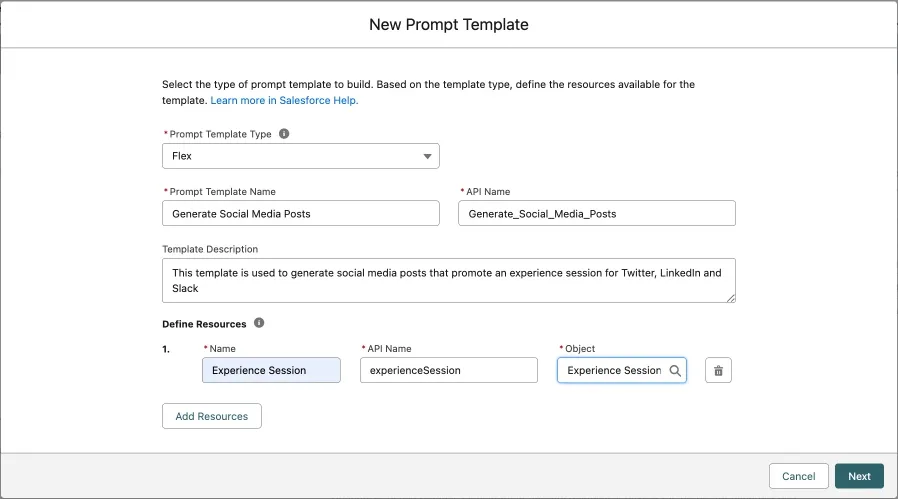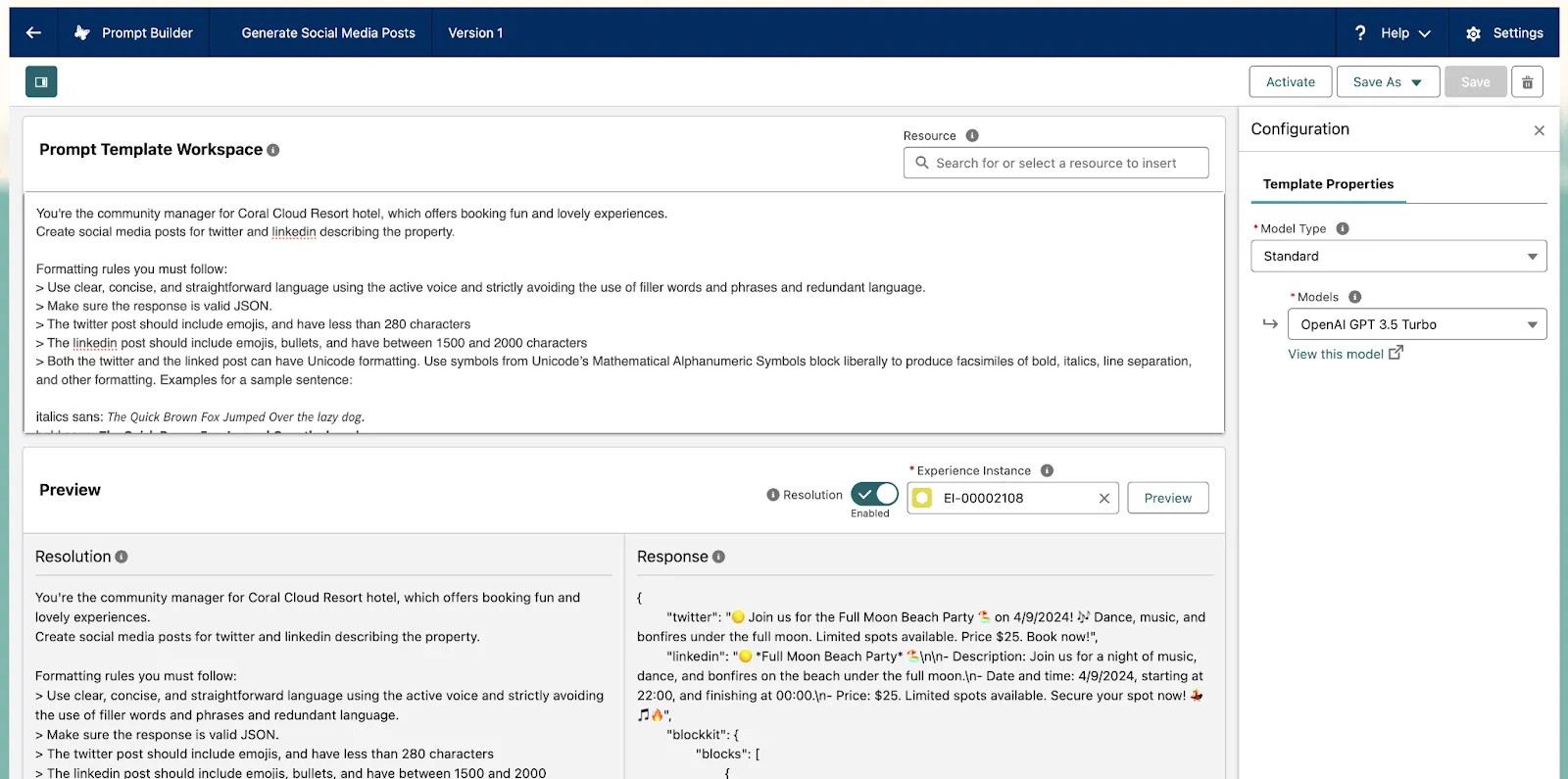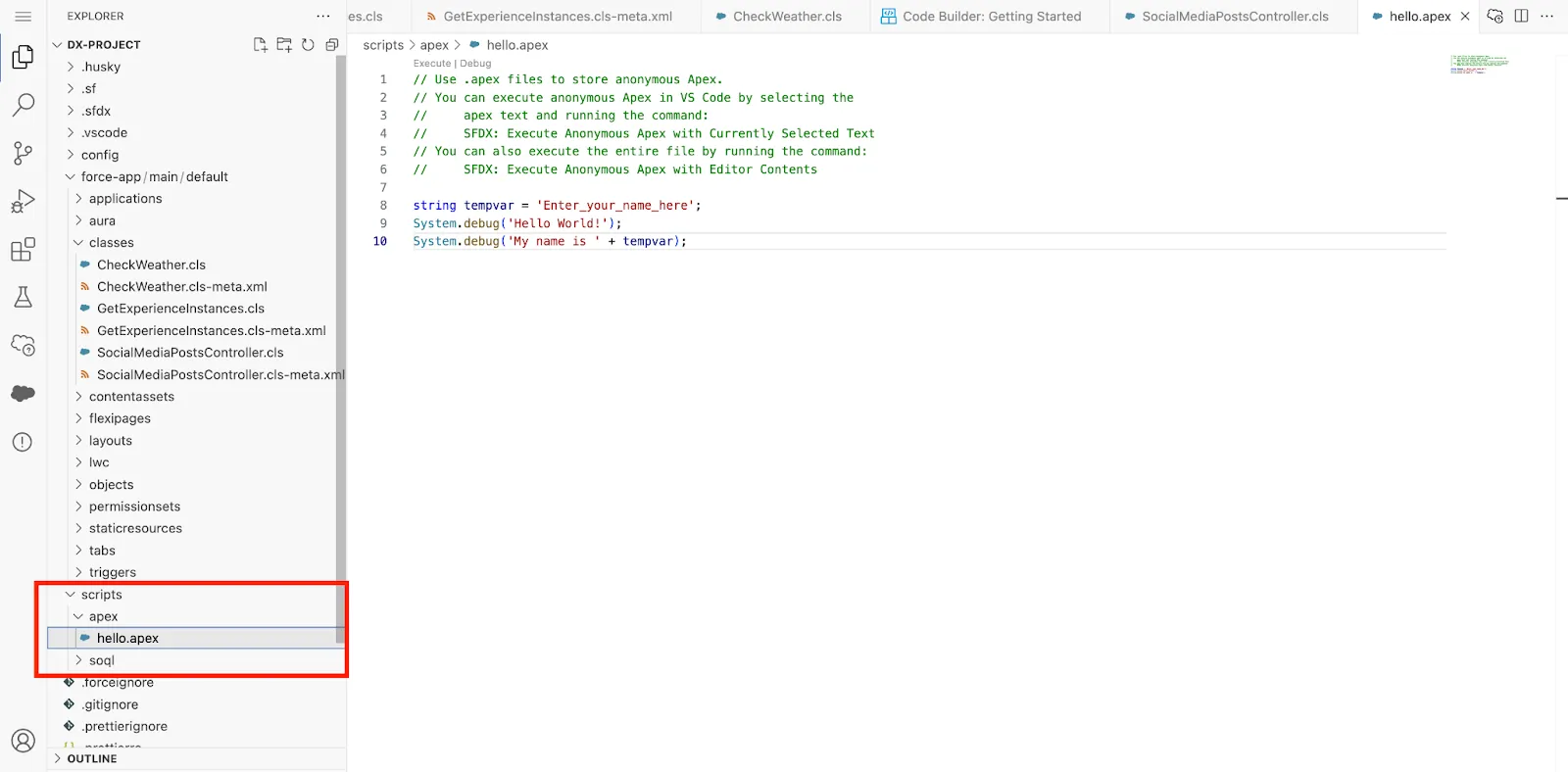Appearance
Exercise 1: Invoke Prompt Templates from Apex and Lightning Web Components
In this exercise, you will create a Flex Template that generates social media posts for resort experiences. You will instruct the template to output the posts content in JSON. You will then invoke that template from an Apex class. Finally, you will create Lightning Web Component that allows users to generate social media posts using the Apex class and the Flex template you created.
Step 1: Create an Advanced Prompt Template
In this step you’ll create a prompt template that creates social media posts for Coral Cloud Resorts experiences.
Open the Setup Menu and click Setup.
In the quick find, search for Prompt Builder and click Prompt Builder.
Click on New Prompt Template.
Configure the prompt template as follows
Field Value Prompt Template Type Flex Prompt Template Name Generate Social Media PostsAPI Name Leave default Template Description This template is used to generate social media posts that promote an experience session for Twitter, LinkedIn and SlackAdd a new resource and configure it as follows
Field Value Name Experience SessionAPI Name experienceSessionObject Experience Session TIP
Make sure you spell the API Name exactly as above (lowercase e, upper case S, no hyphen).

Click on Next.
Add the following text to the prompt template:
txtYou're the community manager for Coral Cloud Resorts, which offers booking fun and lovely experiences. Create social media posts for Twitter, LinkedIn & Slack describing the experience. Formatting rules you must follow: """ > Use clear, concise, and straightforward language using the active voice and strictly avoiding the use of filler words and phrases and redundant language. > Make sure the response is valid JSON. > The Twitter post should include emojis, and have less than 280 characters > The LinkedIn post should include emojis, bullets, and have between 1500 and 2000 characters > Both the Twitter and the LinkedIn posts can have Unicode formatting. Use symbols from Unicode’s Mathematical Alphanumeric Symbols block liberally to produce facsimiles of bold, italics, line separation, and other formatting. Examples for a sample sentence: italics sans: 𝘛𝘩𝘦 𝘘𝘶𝘪𝘤𝘬 𝘉𝘳𝘰𝘸𝘯 𝘍𝘰𝘹 𝘑𝘶𝘮𝘱𝘦𝘥 𝘖𝘷𝘦𝘳 𝘵𝘩𝘦 𝘭𝘢𝘻𝘺 𝘥𝘰𝘨. bold sans: 𝗧𝗵𝗲 𝗤𝘂𝗶𝗰𝗸 𝗕𝗿𝗼𝘄𝗻 𝗙𝗼𝘅 𝗝𝘂𝗺𝗽𝗲𝗱 𝗢𝘃𝗲𝗿 𝘁𝗵𝗲 𝗹𝗮𝘇𝘆 𝗱𝗼𝗴. bold italic sans: 𝙏𝙝𝙚 𝙌𝙪𝙞𝙘𝙠 𝘽𝙧𝙤𝙬𝙣 𝙁𝙤𝙭 𝙅𝙪𝙢𝙥𝙚𝙙 𝙊𝙫𝙚𝙧 𝙩𝙝𝙚 𝙡𝙖𝙯𝙮 𝙙𝙤𝙜. italics serif: 𝑇ℎ𝑒 𝑄𝑢𝑖𝑐𝑘 𝐵𝑟𝑜𝑤𝑛 𝐹𝑜𝑥 𝐽𝑢𝑚𝑝𝑒𝑑 𝑂𝑣𝑒𝑟 𝑡ℎ𝑒 𝑙𝑎𝑧𝑦 𝑑𝑜𝑔. > The block kit code should be valid block kit code for Slack. Example of block kit code: { "blocks": [ { "type": "section", "text": { "type": "mrkdwn", "text": "🌴 *Tropical Snorkel Adventure* 🐠" } }, { "type": "section", "text": { "type": "mrkdwn", "text": "Swim alongside colorful marine life in our coral-rich tropical waters on this guided snorkeling tour.\n\n *Experience characteristics:*" }, "accessory": { "type": "image", "image_url": "{!$Input:experienceSession.Experience__r.Picture_URL__c}", "alt_text": "alt text for image" } }, { "type": "divider" }, { "type": "section", "text": { "type": "mrkdwn", "text": "• Swim alongside colorful marine life in our coral-rich tropical waters on this guided snorkeling tour." } }, { "type": "section", "text": { "type": "mrkdwn", "text": "• Date: 3/11/2024, starting at 16:00, and finishing at 20:00." } }, { "type": "section", "text": { "type": "mrkdwn", "text": "• Price: $50. Spots are limited, secure your spot today! 🏖️" } }, { "type": "divider" }, { "type": "divider" }, { "type": "actions", "elements": [ { "type": "button", "text": { "type": "plain_text", "text": "Book Experience", "emoji": true }, "value": "click_me_123", "url": "https://coralclouds.com/book/{!$Input:experienceSession.Id}" } ] } ] } """ Instructions regarding the content to generate: """ For each post: - Add a title including the name of the experience, {!$Input:experienceSession.Experience__r.Name} - Add a section including the experience characteristics, such as: + Description: {!$Input:experienceSession.Experience__r.Description__c} + Date and time: {!$Input:experienceSession.Date__c}, starting at {!$Input:experienceSession.Start_Time__c}, and finishing at {!$Input:experienceSession.End_Time__c} - Also include a link to the picture of the experience: {!$Input:experienceSession.Experience__r.Picture_URL__c}, or the picture directly in the case of the slack post. - Finally mention the price {!$Input:experienceSession.Experience__r.Price__c} and say spots are limited. The final response should have the next format: { "twitter": [here goes the twitter post], "linkedin": [here goes the linkedin post], "blockkit": [here goes the slack post] } """ Now generate the social media posts.TIP
The technique of passing examples of the format that it should return to the LLM is called “few-shot prompting”.
In the Preview panel, select EI-00002108 for the Experience Session.
Click Save & Preview, and explore the prompt Resolution and Response.
Activate the prompt template.

Step 2: Execute a Prompt Template using the Connect API in Apex
In this step you’ll use the Connect API to execute a prompt from Apex.
From App Launcher, open Code Builder.
Click Launch.
Once it is loaded, open the command palette (CMD+SHIFT+ P on Mac or CTRL+SHIFT+P on PC).
Search for Apex and click Create Apex Class.
Enter SocialMediaPostsController as the class name and accept the default directory.
Replace the default Apex class with the following code:
apexpublic with sharing class SocialMediaPostsController { @AuraEnabled public static String generateSocialMediaPosts(String experienceSessionId) { // Create inputs Map<String, String> experienceSession = new Map<String, String>(); experienceSession.put('id', experienceSessionId); ConnectApi.WrappedValue experienceSessionValue = new ConnectApi.WrappedValue(); experienceSessionValue.value = experienceSession; Map<String, ConnectApi.WrappedValue> inputParams = new Map<String, ConnectApi.WrappedValue>(); inputParams.put('Input:experienceSession', experienceSessionValue); // Configure invocation parameters ConnectApi.EinsteinPromptTemplateGenerationsInput executeTemplateInput = new ConnectApi.EinsteinPromptTemplateGenerationsInput(); executeTemplateInput.additionalConfig = new ConnectApi.EinsteinLlmAdditionalConfigInput(); executeTemplateInput.additionalConfig.applicationName = 'PromptBuilderPreview'; executeTemplateInput.isPreview = false; executeTemplateInput.inputParams = inputParams; try { // Call the service ConnectApi.EinsteinPromptTemplateGenerationsRepresentation generationsOutput = ConnectApi.EinsteinLLM.generateMessagesForPromptTemplate( 'Generate_Social_Media_Posts', executeTemplateInput ); ConnectApi.EinsteinLLMGenerationItemOutput response = generationsOutput.generations[0]; return response.text; } catch (Exception e) { System.debug(e.getMessage()); throw e; } } }The
generateSocialMediaPosts()method is defined as an@AuraEnabledso that it can be invoked from a Lightning Component. The method takes in an Experience Session record Id that it passes into the Generate Social Media Posts prompt template.
The Connect API exposes an EinsteinLLM class that can be used to set up your inputs and invoke prompt templates.Save the file. (CMD+S on Mac or CTRL+S on PC).
Right click anywhere in the code and click SFDX: Deploy This Source to Org.
Step 3: Test the code with anonymous Apex
Test the class in execute anonymous, passing in an experienceSessionId and make sure it returns the LLM response correctly.
Navigate to the scripts/apex directory in your dx-project
Open the hello.apex file

Paste the following code:
apexSession__c experienceSession = [SELECT Id FROM Session__c LIMIT 1]; String socialPosts = SocialMediaPostsController.generateSocialMediaPosts(experienceSession.Id); System.debug(socialPosts);Click on Execute to run the code
Review the output

Step 4: Create a Lightning Web Component that uses Generative AI
In this step you’ll invoke the generateSocialMediaPosts() method from a Lightning Web Component (LWC) to allowusers to generate social media posts directly from an experience session record page.
In Code Builder, open the command palette (CMD+SHIFT+ P on Mac or CTRL+SHIFT+P on PC).
Search for LWC and click Create Lightning Web Component.
Enter generateSocialMediaPosts as the name
Accept the default location
Open generateSocialMediaPosts.html
Replace its content with the following code:
html<template> <lightning-card title="Generate Social Media Posts" icon-name="utility:socialshare" > <div class="slds-var-p-around_small"> <template lwc:if="{error}"> {error} <lightning-button onclick="{generateSocialMediaPosts}" label="Try again!" class="slds-align_absolute-center" > </lightning-button> </template> <template lwc:else> <lightning-button onclick="{generateSocialMediaPosts}" label="Generate Social Media Posts" > </lightning-button> <div class="slds-var-p-top_small"> <lightning-textarea name="twitter" readonly value="{twitterPost}" label="Twitter Post" > </lightning-textarea> </div> <div class="slds-var-p-top_small"> <lightning-textarea name="linkedin" readonly value="{linkedinPost}" label="Linkedin Post" > </lightning-textarea> </div> <div class="slds-var-p-top_small"> <lightning-textarea name="slack" readonly value="{slackPost}" label="Slack Post" > </lightning-textarea> </div> </template> <template lwc:if="{showSpinner}"> <lightning-spinner alternative-text="Loading..." size="small" ></lightning-spinner> </template> </div> </lightning-card> </template>This HTML file defines the UI of the component and includes a button that will execute the prompt template.
Save the file. (CMD+S on Mac or CTRL+S on PC).
Open generateSocialMediaPosts.js
Replace its content with the following code:
javascriptimport { api, LightningElement } from "lwc"; import generateSocialMediaPosts from "@salesforce/apex/SocialMediaPostsController.generateSocialMediaPosts"; export default class GenerateSocialMediaPosts extends LightningElement { twitterPost; linkedinPost; slackPost; error; showSpinner = false; @api recordId; async generateSocialMediaPosts() { this.showSpinner = true; try { const posts = await generateSocialMediaPosts({ experienceSessionId: this.recordId }); const parsedPosts = JSON.parse(posts); this.twitterPost = parsedPosts.twitter; this.linkedinPost = parsedPosts.linkedin; this.slackPost = JSON.stringify(parsedPosts.blockkit); this.error = undefined; } catch (error) { this.twitterPost = undefined; this.linkedinPost = undefined; this.error = error; } finally { this.showSpinner = false; } } }This JavaScript code imports the
generateSocialMediaPosts()method from the SocialMediaPostsController Apex Class. When the Generate Social Media Posts button is clicked it passes the experienceSessionId into the method and returns the response generated by the LLM.Save the file. (CMD+S on Mac or CTRL+S on PC).
Open the generateSocialMediaPosts.js-meta.xml.
Replace its content with the following code:
xml<?xml version="1.0" encoding="UTF-8"?> <LightningComponentBundle xmlns="http://soap.sforce.com/2006/04/metadata"> <apiVersion>60.0</apiVersion> <isExposed>true</isExposed> <masterLabel>Generate Social Media Posts</masterLabel> <targets> <target>lightning__RecordPage</target> </targets> <targetConfigs> <targetConfig targets="lightning__RecordPage"> <objects> <object>Session__c</object> </objects> <supportedFormFactors> <supportedFormFactor type="Large" /> <supportedFormFactor type="Small" /> </supportedFormFactors> </targetConfig> </targetConfigs> </LightningComponentBundle>This XML will allow the component to be exposed on the Experience Session record page.
Save the file. (CMD+S on Mac or CTRL+S on PC).
Right click anywhere in the code and click SFDX: Deploy This Source to Org.
Step 5: Add your component to the Experience Session record page
In the App Launcher, select the Coral Cloud app, click the Experiences tab, and click the Aqua Fitness in Paradise record.
Click the Related tab and click one of the sessions to open the Experience Session record page
Open the Setup menu and click Edit Page.
Drag the Generate Social Media Posts custom component and drop it into the right hand side area of the record page.
Click Save.
Click Activate and Assign as Org Default for Desktop and Phone.
Click the back arrow button to get back to Experience Session record
Go back to the Experience Session record page and click on the Generate Social Media Posts button.
You can see that the prompt was invoked and created social media posts for Twitter, LinkedIn and Slack.